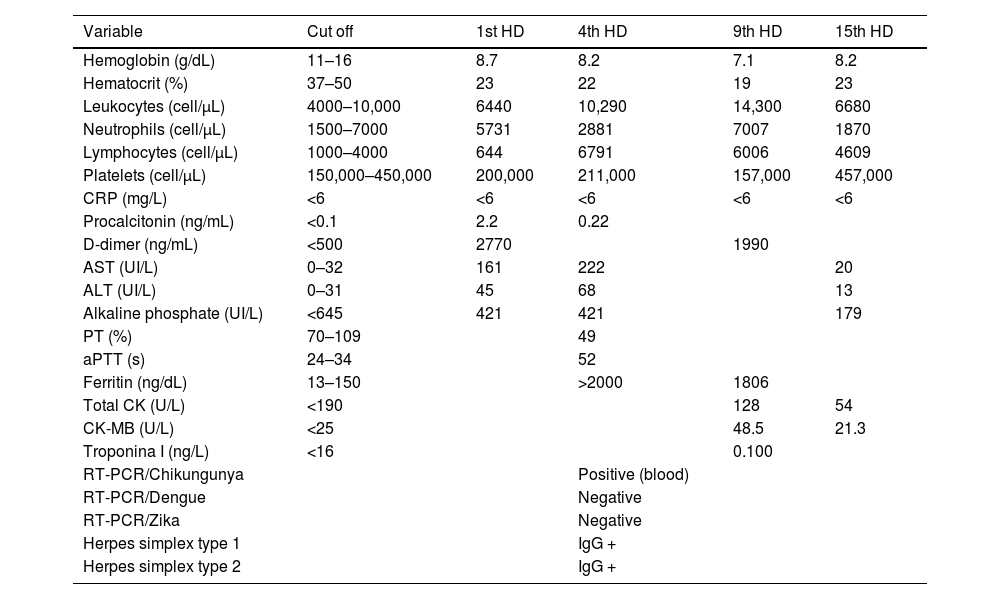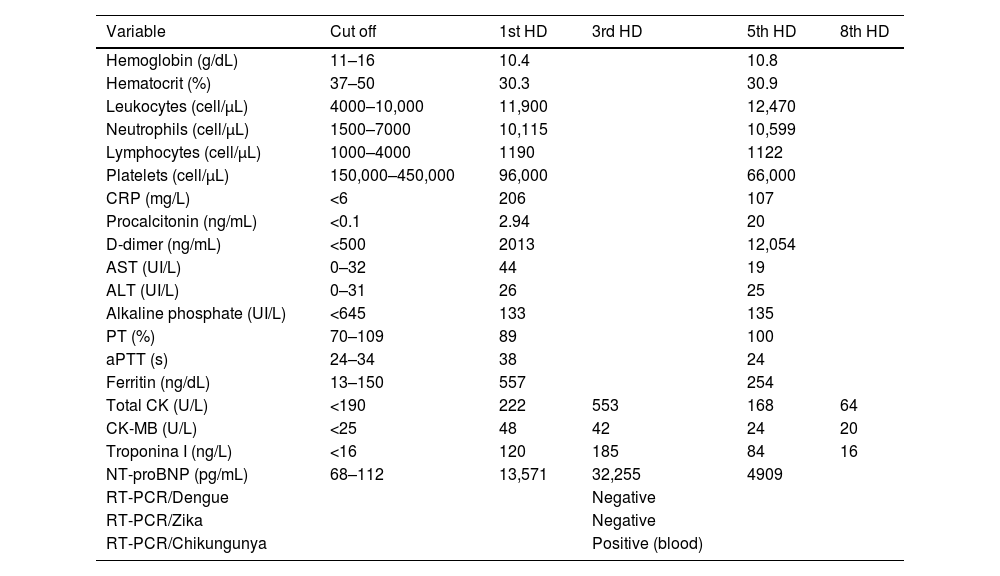Paraguay is currently facing a new outbreak of Chikungunya virus. This report summarizes two severe cases of Chikungunya (CHIKV) infection, confirmed by real-time reverse transcription polymerase chain reaction. We present the cases of patients with acute CHIKV infection and multisystem involvement, with fever, rash, abdominal pain, vomiting, myocarditis, and coronary artery anomalies, very similar to the cases described in MIS-C related to SARS-CoV-2 during the COVID-19 Pandemic. Both patients received IVIG and methylprednisolone, with good clinical response. In this setting of cytokine storm in Chikungunya, can we call it “Multisystem inflammatory syndrome associated with Chikungunya”?.
Paraguay se enfrenta actualmente a un nuevo brote del virus Chikungunya. Este informe resume dos casos graves de infección por Chikungunya (CHIKV), confirmados mediante reacción en cadena de la polimerasa con transcripción inversa en tiempo real. Presentamos los casos de pacientes con infección aguda por CHIKV y afectación multisistémica, con fiebre, erupción cutánea, dolor abdominal, vómitos, miocarditis y anomalías de las arterias coronarias, muy similares a los casos descritos en síndrome inflamatorio multisistémico relacionado con el SARS-CoV-2 durante la pandemia de COVID-19. Ambos pacientes recibieron IGIV y metilprednisolona, con buena respuesta clínica. En este escenario de tormenta de citoquinas en Chikungunya, ¿podemos llamarla «síndrome inflamatorio multisistémico asociado a Chikungunya»?
Cytokine storm and cytokine release syndrome are life-threatening systemic inflammatory syndromes involving elevated levels of circulating cytokines and immune-cell hyperactivation that can be triggered by various pathogens, cancers, autoimmune conditions, therapies, and monogenic disorders.1
During the Coronavirus-19 (COVID-19) pandemic, the Syndrome called pediatric multisystem inflammatory syndrome has been seen temporally associated with COVID-19 (MIS-TS) or multisystem inflammatory syndrome in children (MIS-C), with the presence of cardiovascular shock, myocarditis, significant gastrointestinal (GI) symptoms, mild or absent respiratory symptoms, and a variable incidence of skin rash, red eyes, and changes in the oral mucosa, besides excessive inflammatory markers.2–4
In the actual outbreak of Chikungunya virus (CHIKV) in Paraguay,5,6 we have seen some cases of neonates, infants and elderly patients with cytokine release syndrome.
We present two patients with cytokine storm related to CHIKV.
CasesCase 1Female patient, 1 month old, with a history of 5 days of fever up to 39°C, generalized erythema sparing the palmoplantar region, and a large numbers of bullous lesions on the upper and lower limbs and trunk, irritability and food rejection (Fig. 1). She was admitted to the hospital, with a decompensated septic shock. Laboratory showed anemia, high levels of ferritin, D-dimer, procalcitonin and cardiac enzymes (Table 1). Echocardiogram: compatible with myocarditis and mild mitral and tricuspid valve regurgitation. The blood culture was negative, RT-PCR for SARS-CoV-2 negative, SARS-CoV-2 IgG and IgM were negative and RT-PCR for Chikungunya virus was positive. She required mechanical respiratory assistance, fluid boluses, intravenous antibiotics (cefotaxime and vancomycin), and adrenaline. She also received a transfusion of red blood cells, vitamin K, a single dose of intravenous immunoglobulin 2000g/kg and methylprednisolone 2mg/kg/day for 5 days, due to multisystem inflammatory syndrome with myocarditis. The patient recovered and was discharged after 15 days of hospitalization.
Laboratory findings of the Case 1.
| Variable | Cut off | 1st HD | 4th HD | 9th HD | 15th HD |
|---|---|---|---|---|---|
| Hemoglobin (g/dL) | 11–16 | 8.7 | 8.2 | 7.1 | 8.2 |
| Hematocrit (%) | 37–50 | 23 | 22 | 19 | 23 |
| Leukocytes (cell/μL) | 4000–10,000 | 6440 | 10,290 | 14,300 | 6680 |
| Neutrophils (cell/μL) | 1500–7000 | 5731 | 2881 | 7007 | 1870 |
| Lymphocytes (cell/μL) | 1000–4000 | 644 | 6791 | 6006 | 4609 |
| Platelets (cell/μL) | 150,000–450,000 | 200,000 | 211,000 | 157,000 | 457,000 |
| CRP (mg/L) | <6 | <6 | <6 | <6 | <6 |
| Procalcitonin (ng/mL) | <0.1 | 2.2 | 0.22 | ||
| D-dimer (ng/mL) | <500 | 2770 | 1990 | ||
| AST (UI/L) | 0–32 | 161 | 222 | 20 | |
| ALT (UI/L) | 0–31 | 45 | 68 | 13 | |
| Alkaline phosphate (UI/L) | <645 | 421 | 421 | 179 | |
| PT (%) | 70–109 | 49 | |||
| aPTT (s) | 24–34 | 52 | |||
| Ferritin (ng/dL) | 13–150 | >2000 | 1806 | ||
| Total CK (U/L) | <190 | 128 | 54 | ||
| CK-MB (U/L) | <25 | 48.5 | 21.3 | ||
| Troponina I (ng/L) | <16 | 0.100 | |||
| RT-PCR/Chikungunya | Positive (blood) | ||||
| RT-PCR/Dengue | Negative | ||||
| RT-PCR/Zika | Negative | ||||
| Herpes simplex type 1 | IgG + | ||||
| Herpes simplex type 2 | IgG + |
HD=hospitalization day.
A previously healthy 7-year-old female was admitted with a case history of 5 days joint pain in hands and ankles, generalized rash, fever up to 39°C, abdominal pain and vomiting. She was hospitalized due to poor general conditions, with signs of septic shock. Laboratory showed anemia, thrombocytopenia and high levels of CRP, ferritin, D-dimer, procalcitonin and cardiac enzymes; blood cultures, RT-PCR for SARS-CoV-2 and SARS-CoV-2 IgG and IgM were negative; RT-PCR for Chikungunya virus was positive (Table 2). Echocardiogram: Left coronary artery hyper-refringence with preserved functionality. She required intubation, fluid boluses, intravenous antibiotics (cefotaxima and vancomycin), and adrenaline. Also, she received IGIV 2g/kg and methylprednisolone 2mg/kg/day for 5 days, due to multisystem inflammatory syndrome with myocarditis. The patient recovered and was discharged after 10 days of hospitalization.
Laboratory results of the Case 2.
| Variable | Cut off | 1st HD | 3rd HD | 5th HD | 8th HD |
|---|---|---|---|---|---|
| Hemoglobin (g/dL) | 11–16 | 10.4 | 10.8 | ||
| Hematocrit (%) | 37–50 | 30.3 | 30.9 | ||
| Leukocytes (cell/μL) | 4000–10,000 | 11,900 | 12,470 | ||
| Neutrophils (cell/μL) | 1500–7000 | 10,115 | 10,599 | ||
| Lymphocytes (cell/μL) | 1000–4000 | 1190 | 1122 | ||
| Platelets (cell/μL) | 150,000–450,000 | 96,000 | 66,000 | ||
| CRP (mg/L) | <6 | 206 | 107 | ||
| Procalcitonin (ng/mL) | <0.1 | 2.94 | 20 | ||
| D-dimer (ng/mL) | <500 | 2013 | 12,054 | ||
| AST (UI/L) | 0–32 | 44 | 19 | ||
| ALT (UI/L) | 0–31 | 26 | 25 | ||
| Alkaline phosphate (UI/L) | <645 | 133 | 135 | ||
| PT (%) | 70–109 | 89 | 100 | ||
| aPTT (s) | 24–34 | 38 | 24 | ||
| Ferritin (ng/dL) | 13–150 | 557 | 254 | ||
| Total CK (U/L) | <190 | 222 | 553 | 168 | 64 |
| CK-MB (U/L) | <25 | 48 | 42 | 24 | 20 |
| Troponina I (ng/L) | <16 | 120 | 185 | 84 | 16 |
| NT-proBNP (pg/mL) | 68–112 | 13,571 | 32,255 | 4909 | |
| RT-PCR/Dengue | Negative | ||||
| RT-PCR/Zika | Negative | ||||
| RT-PCR/Chikungunya | Positive (blood) |
HD=hospitalization day.
Since April 2020, several authors reported young patients with a severe multisystem inflammatory syndrome associated with SARS-CoV-2. The multisystem inflammatory syndrome in children (MIS-C) is a rare post-infectious hyperinflammatory disorder associated with SARS-CoV-2. This syndrome is characterized by overwhelming systemic inflammation, fever, hypotension, and cardiac dysfunction. However, this clinical presentation could also occur in the setting of infections related to other pathogens, related to a cytokine storm.1,7
We are currently facing a new outbreak of Chikungunya in Paraguay, with 59,812 confirmed plus probable cases reported up to epidemiological week 12 of 2023 (March 30, 2023), but with a significant unreported cases, with 70 deaths at this time.8
We present two patients with acute and severe CHIKV infection and clinical and laboratory data of multisystem involvement, with fever, rash, abdominal pain, vomiting, signs of shock, high levels of CRP, ferritin, D-dimer, procalcitonin and cardiac enzymes, myocarditis, and coronary artery anomalies. All this, very similar to the cases described in MIS-C related to SARS-CoV2 during the COVID-19 pandemic.7,9,10
According to Chirathaworn et al.,11 CHIKV initiates a cellular immune response with elevated level of cytokines, such IL-6, granulocyte colony-stimulating factor (G-CSF), granulocyte-macrophage colony-stimulating factor (GM-CSF), MCP-1, and TNF-α, and an induction of an interferon-inducing cytokine, IL-18, which could explain the severe clinical presentation with multisystem involvement. Unfortunately, we were unable to investigate these cytokines in our patients.
Other cases with myocarditis, in addition to encephalitis, especially in neonates and infants were reported in CHIKV.12–16
Regarding treatment, patients received IVIG and methylprednisolone, as in MIS-C for SARS-CoV-2,17 with good clinical response.
In conclusion, we present two cases of MIS-C related to Chikungunya virus, with good response to IGIV and corticosteroids. We reflect “Can we call it MIS-C related to CHIKV?”. This case report should deserve attention in the investigation of cases like these, in countries with arbovirus infections.
Conflict of interestsThe authors declare that they have no conflict of interest.










